Discover space-saving solutions for storing bicycles in apartments, garages, and outdoor spaces with expert tips and proven storage strategies
Finding the right bike storage systems can transform your living space while protecting your valuable cycling investment. Whether you face the challenge of storing a bicycle in an apartment, securing bikes in your garage, or weatherproofing outdoor storage, the right solution makes all the difference.
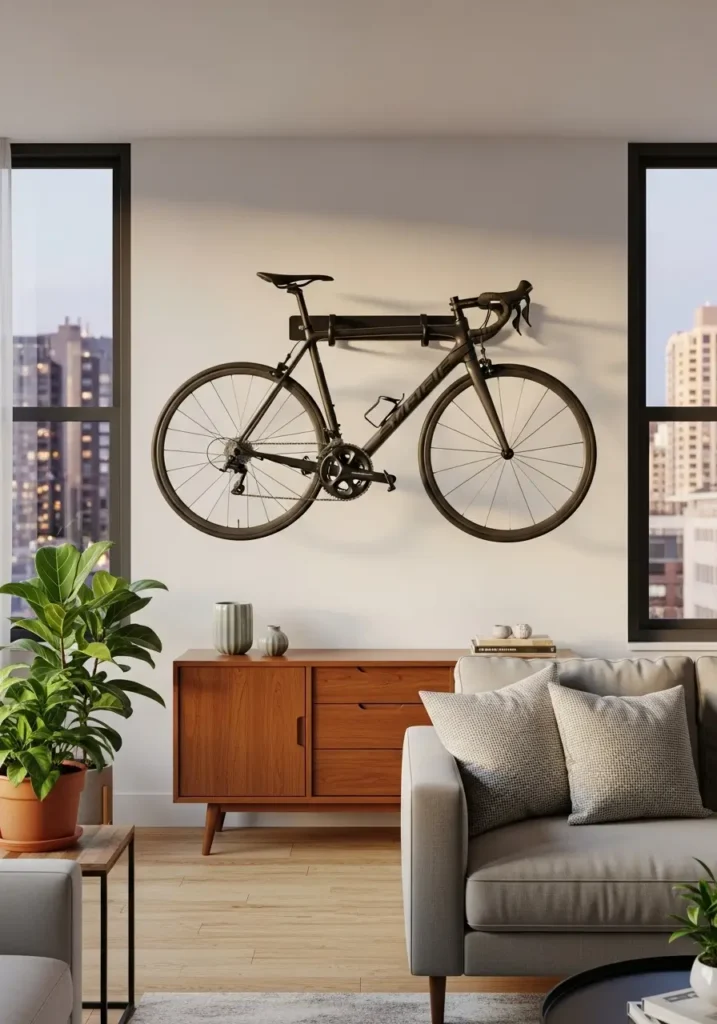
Modern cyclists need storage solutions that balance space efficiency, security, and accessibility. From compact vertical wall mounts perfect for city apartments to robust outdoor sheds designed for multiple bikes, today’s storage options cater to every lifestyle and budget.
This comprehensive guide examines the most effective bike storage approaches, helping you choose systems that protect your bikes while maximizing your available space. We’ll explore indoor and outdoor solutions, space-saving techniques, and security considerations that keep your bikes safe and accessible.
Understanding Your Bike Storage Requirements
Space Assessment and Planning
Before selecting bike storage systems, evaluate your available space carefully. Measure ceiling height, wall dimensions, and floor area to determine which storage methods work best for your situation.
Indoor Storage Considerations
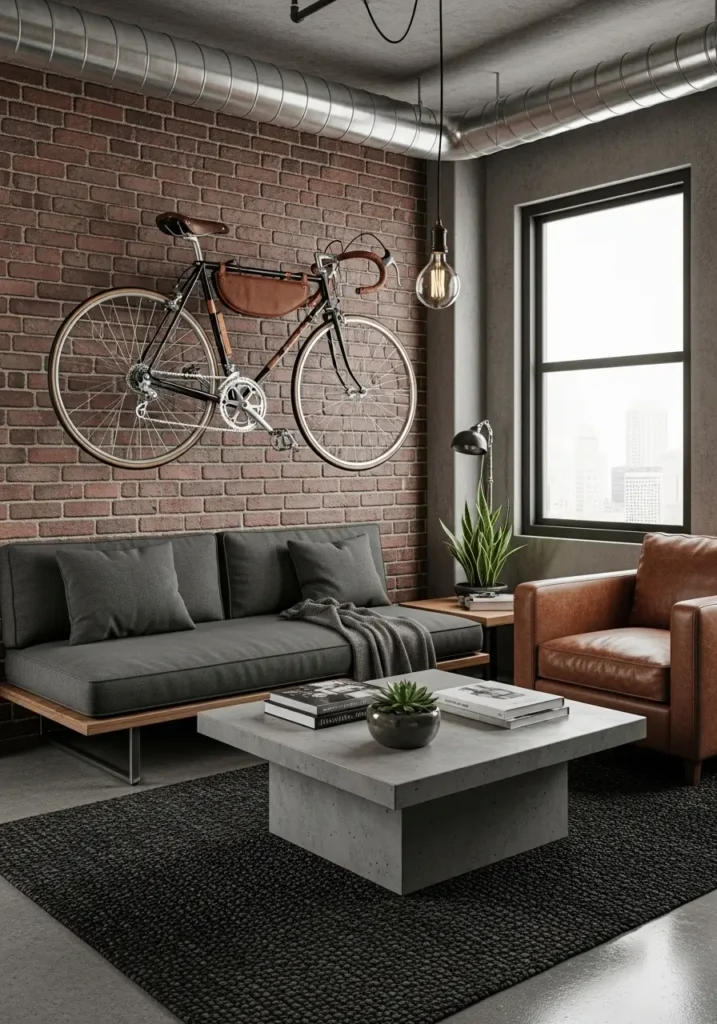
- Available wall space for mounting systems
- Ceiling height for vertical storage
- Floor space constraints
- Access frequency requirements
Outdoor Storage Factors
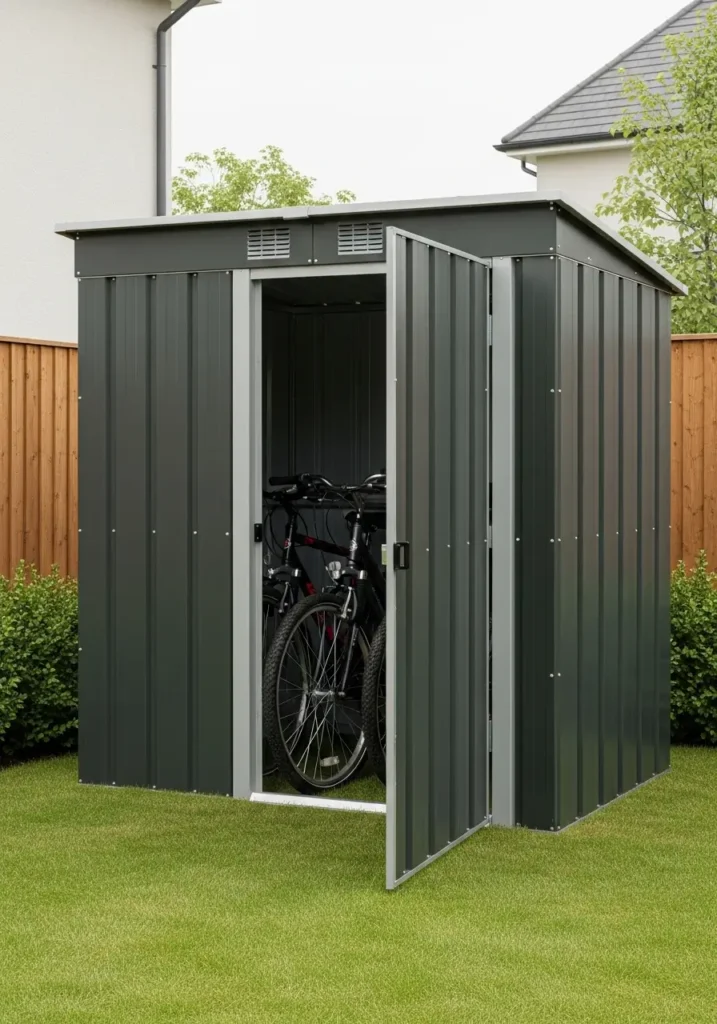
- Weather protection needs
- Security requirements
- Ground surface conditions
- Local theft risk assessment
The number of bikes you need to store significantly impacts your storage system choice. Single bike solutions offer different advantages compared to multi-bike systems, particularly regarding space utilization and cost effectiveness.
Consider your bike types when selecting storage systems. Road bikes, mountain bikes, electric bikes, and cargo bikes each present unique storage challenges due to their different weights, dimensions, and component configurations.
Indoor Bike Storage Systems
Storing a Bicycle in an Apartment
Apartment living presents unique storage challenges where space comes at a premium. Wall-mounted hooks offer excellent options for maximizing floor space in apartments, with horizontal bike racks being particularly effective for space optimization. These solutions transform your bike into functional wall art while keeping it easily accessible.
Wall-Mounted Storage Options
Horizontal Wall Mounts
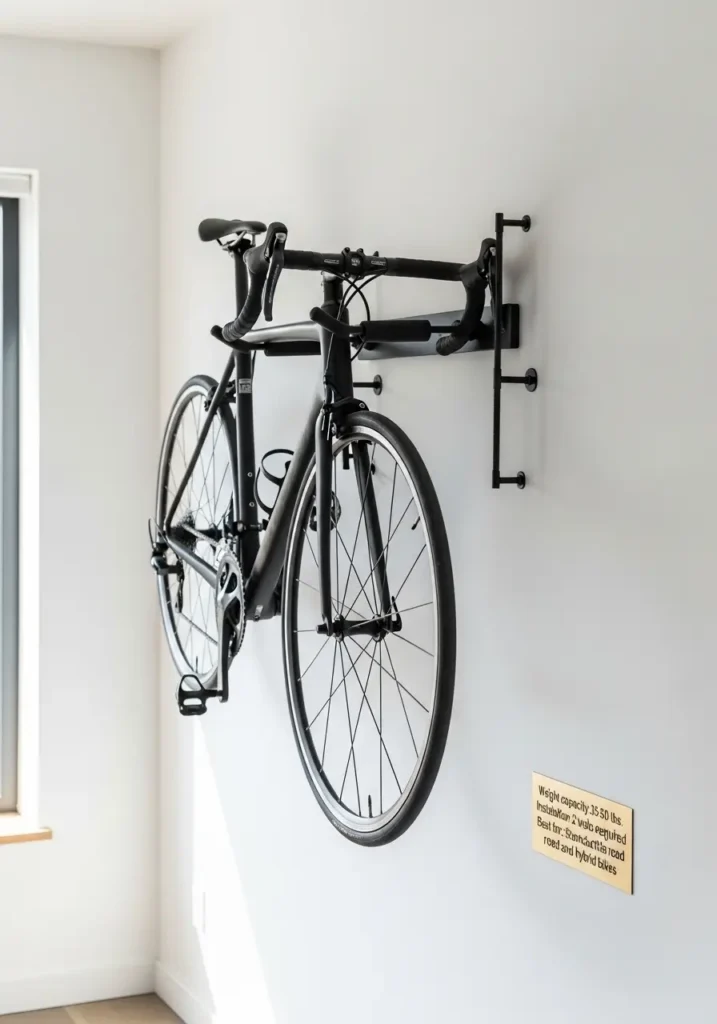
Mount bikes parallel to the wall, saving significant floor space while creating an attractive display.
- Weight capacity: 35-50 lbs typically
- Installation: 2 wall studs required
- Best for: Standard road and hybrid bikes
Vertical Wall Hooks

Store bikes vertically by hanging from the front wheel, excellent for narrow spaces.
- Weight capacity: 40-60 lbs
- Installation: Single wall stud mounting
- Best for: Mountain bikes and heavier frames
Ceiling-mounted systems provide another space-saving option for apartment dwellers. Pulley systems like the Wallmaster ceiling-mounted hoist can lift bikes up to 100 pounds and up to 12 feet high, featuring locking mechanisms to prevent accidental release. These systems work particularly well in apartments with high ceilings or loft-style layouts.
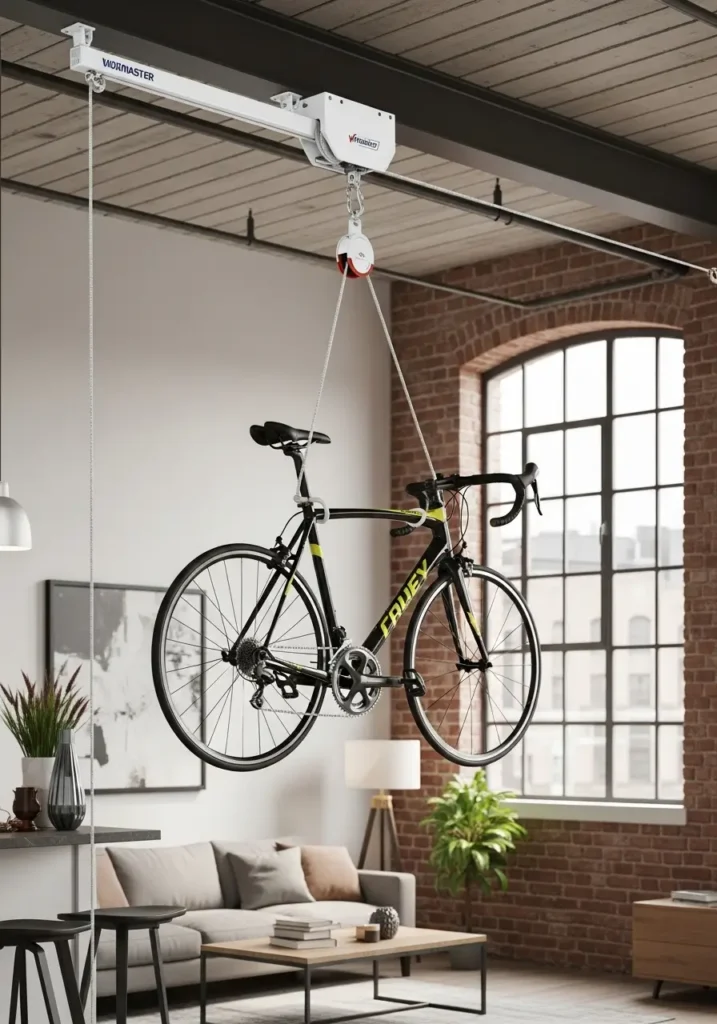
Apartment Storage Tips
- Always check lease agreements before installing wall-mounted systems
- Use rubber-coated hooks to protect bike frames and wall surfaces
- Position storage away from high-traffic areas to prevent accidents
- Consider removable floor stands for rental properties
Storing Bicycles in Garage Spaces
Garage storage offers more flexibility and space compared to apartment solutions. Modern garage bike racks allow you to store more bikes in less space while accommodating any type of bike, making garage bike storage simple and organized. The key lies in utilizing vertical space and implementing systems that accommodate multiple bikes efficiently.
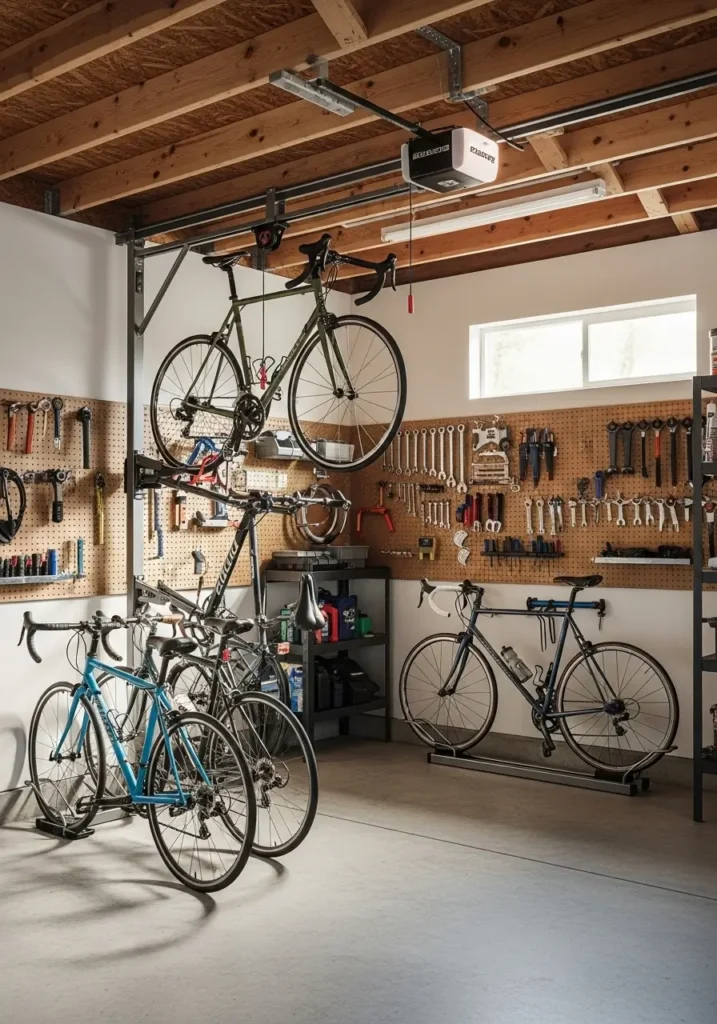
Garage bike storage systems should accommodate seasonal changes in bike usage. Design your storage layout to provide easy access to frequently used bikes while keeping seasonal or spare bikes in less accessible positions.
Advanced Garage Storage Techniques
Multi-level storage systems maximize garage capacity by utilizing different height zones. Install ceiling tracks for less frequently used bikes while keeping daily riders on easily accessible floor or low wall mounts.
Modular Track Systems
Wall-mounted track systems allow flexible positioning of bike hooks and accessories. These systems adapt as your bike collection changes and accommodate different bike styles on the same track.
- Adjustable hook positions for different bike geometries
- Integrated accessory storage for helmets and tools
- Expandable design for growing bike collections
Outdoor Bike Storage Solutions
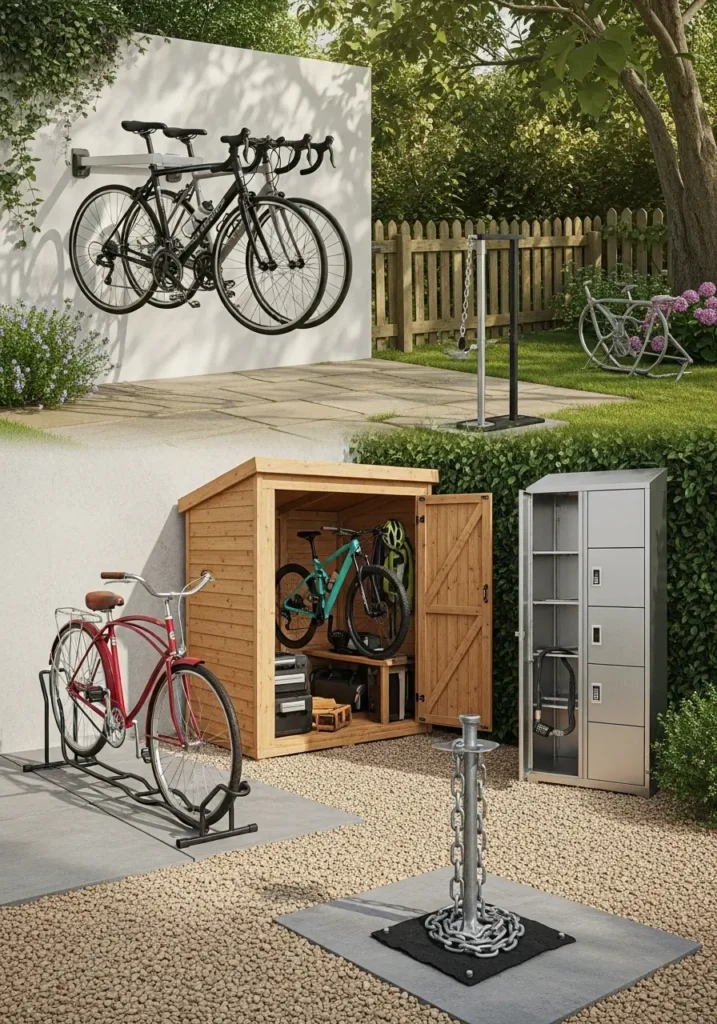
Security Considerations for Outdoor Storage
Storing bicycles outside requires balancing convenience with security and weather protection. While garden sheds and garages attract organized bike thieves, outdoor storage remains viable for remote areas or lower-value bikes, particularly for freeing up indoor space.
Storing a Bicycle Outside: Weather Protection
Outdoor bicycle storage demands robust weather protection to prevent rust, component degradation, and theft. Modern outdoor storage solutions range from simple bike covers to sophisticated locked enclosures that rival indoor security.
Bike Sheds and Lockers
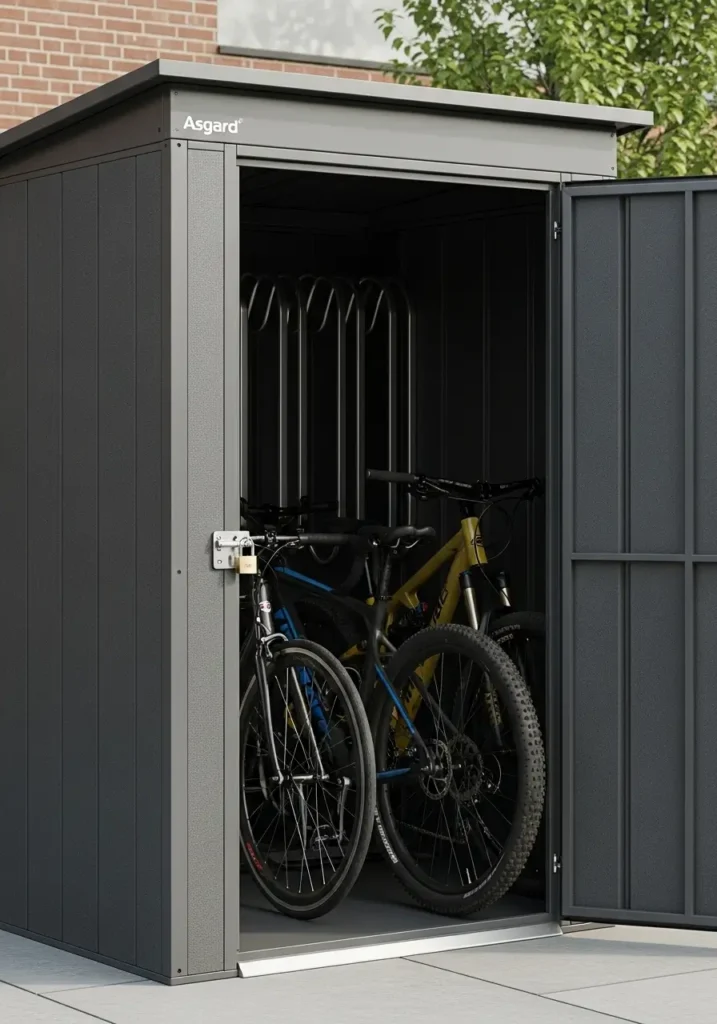
The Asgard Annexe bike shed remains a standout option with reinforced steel construction and integral locking systems, perfect for expensive bikes. These provide maximum security and weather protection.
- Steel construction resists cutting and prying
- Integral locks eliminate weak points
- Ventilation prevents condensation damage
- Ground anchor points for added security
Bike Covers and Tents
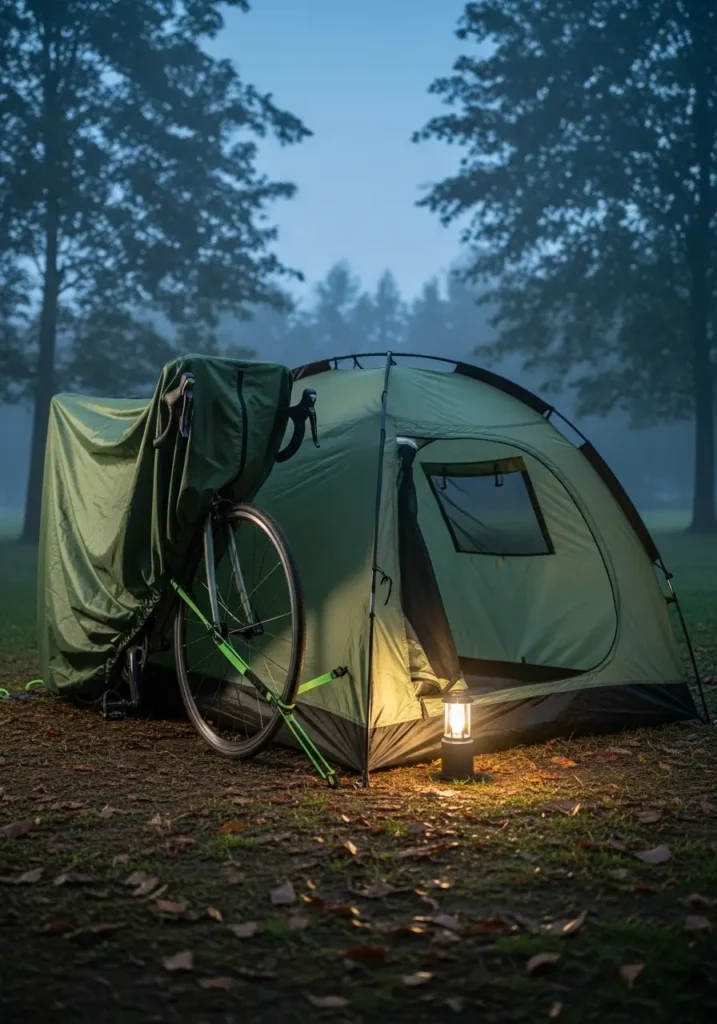
Portable weather protection offers flexibility for temporary outdoor storage or rental properties where permanent installations aren’t possible.
- Waterproof materials with UV protection
- Quick setup and takedown capability
- Ventilation features prevent mold growth
- Compact storage when not in use
Wall-Mounted Outdoor Racks
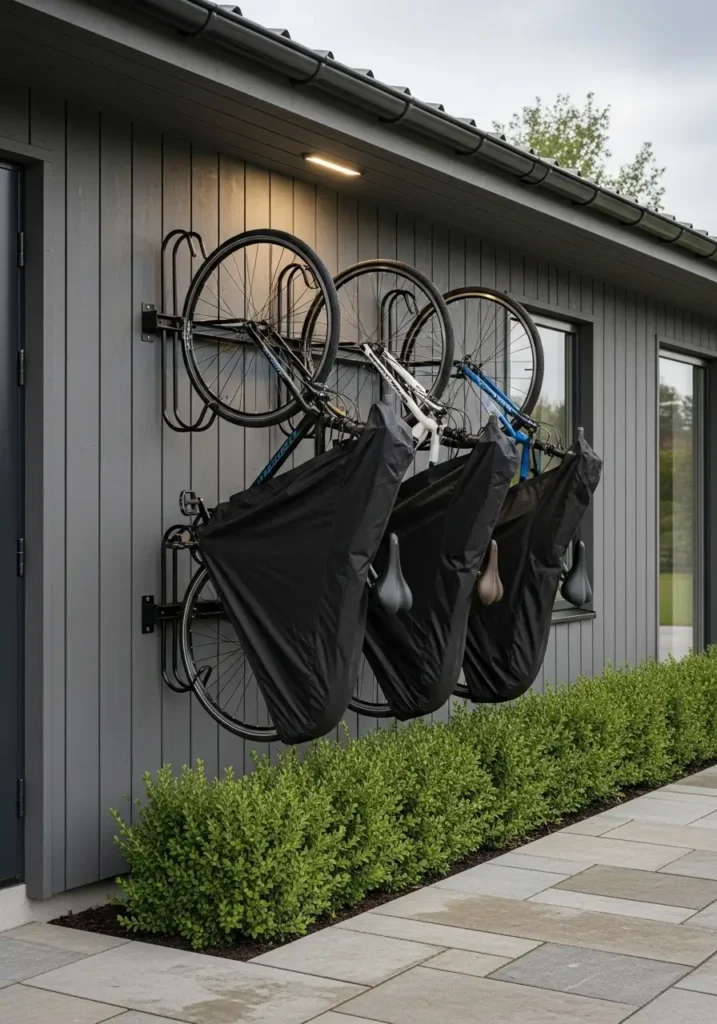
Exterior wall mounting saves ground space while providing reasonable weather protection when combined with bike covers.
- Stainless steel construction resists corrosion
- Multiple locking points for security
- Adjustable arms accommodate different bikes
- Compatible with bike cover systems
Critical Outdoor Storage Guidelines
- Never rely solely on bike covers for high-value bikes
- Ensure adequate drainage around storage areas
- Regular maintenance becomes more critical with outdoor storage
- Consider insurance implications of outdoor storage
- Install motion-activated lighting for deterrence
Bicycle Cycle Stand Solutions
Bicycle cycle stands provide portable, flexible storage options that work in various environments. These systems offer excellent value for cyclists who need adaptable storage solutions or rent their living spaces.
Types of Bicycle Cycle Stands
Floor-Standing Racks
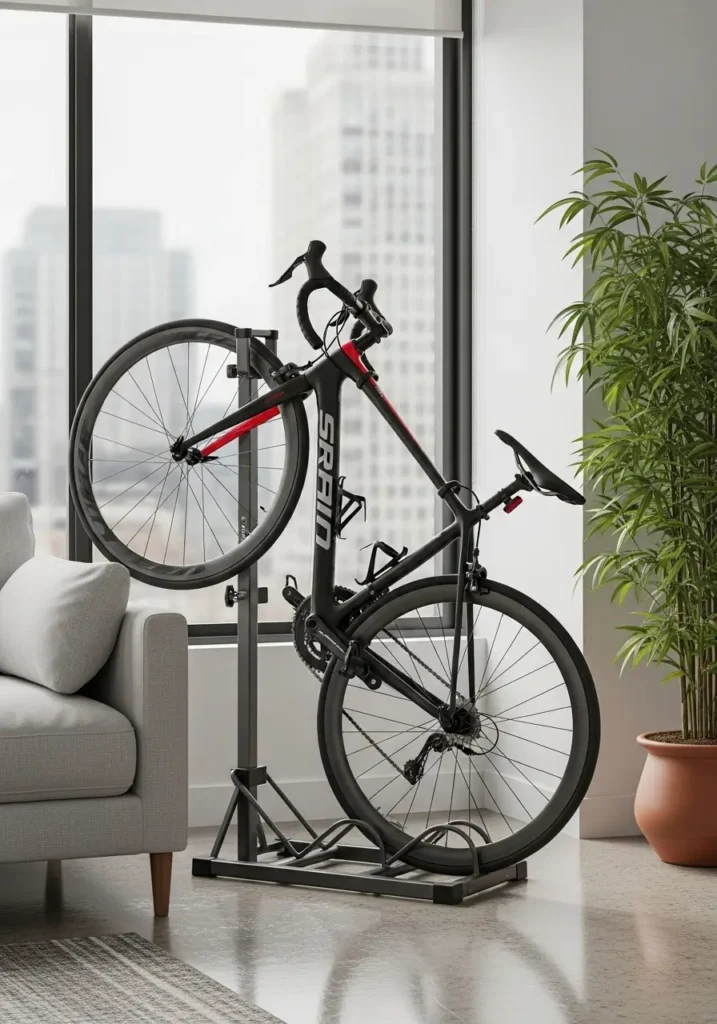
Freestanding units that hold bikes upright without wall or ceiling mounting. The Bike Nook saves space compared to other floor models but may struggle with stability for heavy or oddly weighted bikes.
Key Features:
- No installation required
- Capacity for 1-6 bikes typically
- Adjustable spacing for different bike sizes
- Portable for seasonal storage needs
Gravity Stands
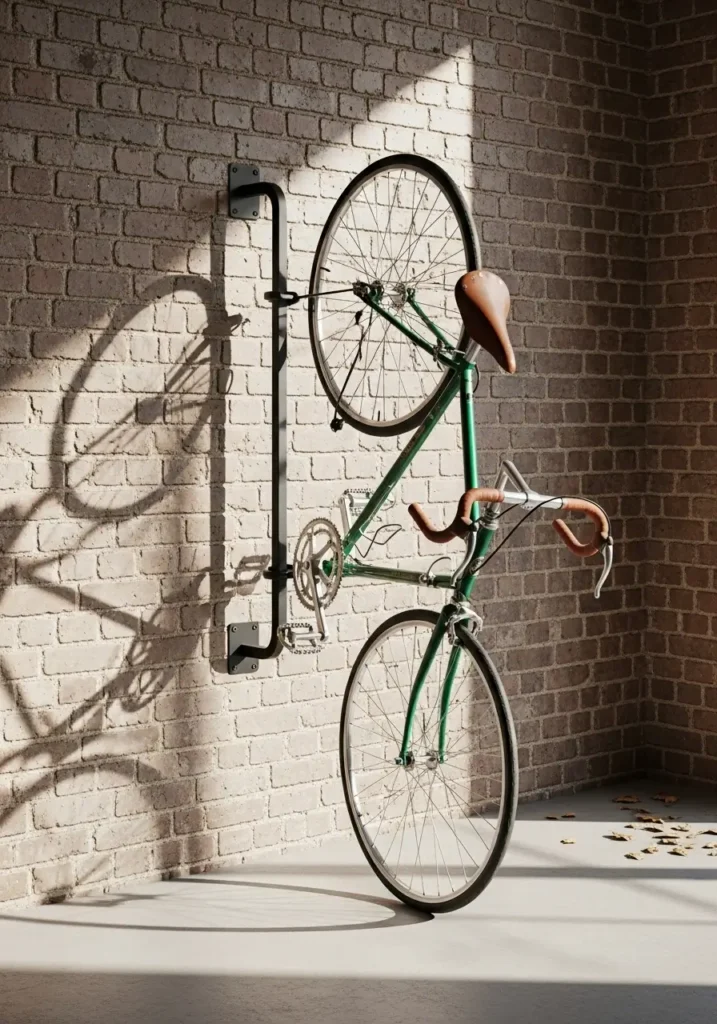
Simple stands that lean against walls for support, offering space-efficient storage with minimal floor footprint.
Advantages:
- Minimal space requirements
- Wall protection features
- Quick bike access
- Cost-effective solution
Choosing the Right Bicycle Cycle Stand
Stand selection depends on your bike types, available space, and usage patterns. Consider weight capacity, stability features, and compatibility with different bike geometries when making your choice.
Security and Maintenance Considerations
Protecting Your Investment
Modern bicycles represent significant financial investments, often valued between $500 and $5,000 or more. Your storage system should provide security proportional to your bike’s value while maintaining convenient access for regular use.
Effective bike security combines multiple layers: physical storage security, environmental protection, and strategic location selection. The best storage systems integrate these elements seamlessly.
Multi-Layer Security Strategies
Physical Security Measures
- High-grade locks integrated into storage systems
- Reinforced mounting points that resist tampering
- Hidden or enclosed storage to reduce visibility
- Multiple locking points for expensive bikes
Environmental Protection
- Moisture control systems prevent rust and corrosion
- UV protection for outdoor and garage storage
- Temperature stability reduces component wear
- Ventilation prevents condensation buildup
Insurance considerations become critical when storing valuable bikes. Many homeowner’s and renter’s insurance policies have specific limitations on bike coverage, particularly for outdoor storage. Verify your coverage limits and consider supplemental bike insurance for high-value collections.
Maintenance Best Practices for Stored Bikes
Proper storage maintenance extends bike life and ensures reliable performance. Different storage environments require specific maintenance approaches to prevent common issues like rust, tire deflation, and component degradation.
Weekly Maintenance Tasks
- Check tire pressure and inflate as needed
- Inspect storage system stability and security
- Verify bike position prevents stress on components
- Clean exposed surfaces to prevent buildup
Monthly Deep Care
- Lubricate chain and moving components
- Check brake cable tension and adjustment
- Inspect storage hooks and mounts for wear
- Rotate bike positions if storing multiple units
Investment Analysis: Storage System Costs and Returns
Quality bike storage systems represent investments that protect much larger bicycle investments. Understanding the cost-benefit relationship helps you select storage solutions that provide optimal value while protecting your cycling assets effectively.
Storage System Investment Ranges
Return on Investment Calculations
Storage system ROI extends beyond simple theft prevention. Factor in reduced maintenance costs from proper storage, extended bike component life, and preserved resale values when calculating total returns.
Direct Cost Savings
- Reduced theft risk and insurance claims
- Lower component replacement frequency
- Decreased weather damage repairs
- Maintained resale value preservation
Indirect Benefits
- Space optimization and organization
- Improved home aesthetics and functionality
- Enhanced cycling frequency through accessibility
- Peace of mind and reduced stress
Innovation and Future Trends in Bike Storage
Smart Storage Technologies
The bike storage industry continues evolving with smart technologies, automated systems, and sustainable materials. These innovations address growing urban density challenges while improving security and user experience.
Emerging Storage Technologies
Automated Storage Systems
Robotic storage systems automatically position and retrieve bikes, maximizing space efficiency in urban environments. These systems integrate smartphone apps for seamless access control.
Key Features:
- Touch-screen or app-based access
- Real-time availability tracking
- Integrated security systems
- Weather protection capabilities
Sustainable Materials
Next-generation storage systems utilize recycled materials, renewable resources, and carbon-neutral manufacturing processes to reduce environmental impact.
Materials Innovation:
- Recycled steel and aluminum components
- Bio-based plastic alternatives
- FSC-certified wood elements
- Low-impact manufacturing processes
Urban planning increasingly incorporates bike storage infrastructure as cities prioritize sustainable transportation. This trend drives innovation in space-efficient, secure storage solutions that integrate seamlessly into residential and commercial developments.
Future Storage Considerations
Electric bike adoption drives demand for storage systems with integrated charging capabilities. Modern storage solutions increasingly accommodate heavier e-bikes while providing secure charging infrastructure.
Consider future-proofing your storage system selection by choosing designs that adapt to changing bike technologies and expanding collection sizes.
Installation Options: Professional vs. DIY Approaches
Installation complexity varies significantly among bike storage systems. While simple wall hooks require basic DIY skills, sophisticated ceiling systems or outdoor sheds often benefit from professional installation to ensure safety and optimal performance.
DIY-Friendly Storage Projects
Basic Wall Mount Installation
Most homeowners can successfully install wall-mounted hooks and horizontal racks with standard tools and basic knowledge of wall construction.
Required Tools:
- Stud finder and level
- Power drill with bits
- Screwdriver set
- Measuring tape
Floor Stand Assembly
Freestanding floor racks typically require only assembly skills and offer immediate use without permanent installation.
Professional Installation Benefits
Complex System Installation
Ceiling hoists, track systems, and outdoor shed installations benefit from professional expertise to ensure safety and warranty compliance.
Professional Advantages:
- Structural integrity assessment
- Proper load distribution calculations
- Warranty protection maintenance
- Code compliance verification
Custom Solutions
Professional installers can create custom storage solutions tailored to unique space constraints and specific bike collections.
Installation Safety Guidelines
- Always locate and secure into wall studs for load-bearing installations
- Verify ceiling structure capacity before installing overhead systems
- Follow manufacturer weight limits precisely to prevent failures
- Consider professional consultation for valuable bike collections
Additional Resources and Expert Guidance
Selecting the optimal bike storage system requires understanding your specific needs, space constraints, and security requirements. Professional guidance and detailed product research ensure you invest in solutions that provide long-term satisfaction and bike protection.
Recommended Expert Resources
For comprehensive bike storage guidance and professional product recommendations, consult established cycling industry resources. Bicycling Magazine’s storage solutions guide provides detailed reviews and testing results for various storage systems across different price points and applications.
Professional installation services and custom storage solutions can be found through REI’s expert advice section, which offers comprehensive guidance on storage system selection, installation techniques, and maintenance best practices for various storage environments.
Conclusion: Building Your Perfect Bike Storage Solution
Effective bike storage systems transform cycling from a logistical challenge into a seamless lifestyle choice. Whether you’re storing a bicycle in an apartment, organizing multiple bikes in your garage, or creating secure outdoor storage, the right system protects your investment while enhancing your daily cycling experience.
The best storage solutions balance security, accessibility, space efficiency, and long-term durability. By understanding your specific needs and investing in quality systems, you ensure your bikes remain protected, accessible, and ready for every cycling adventure.





